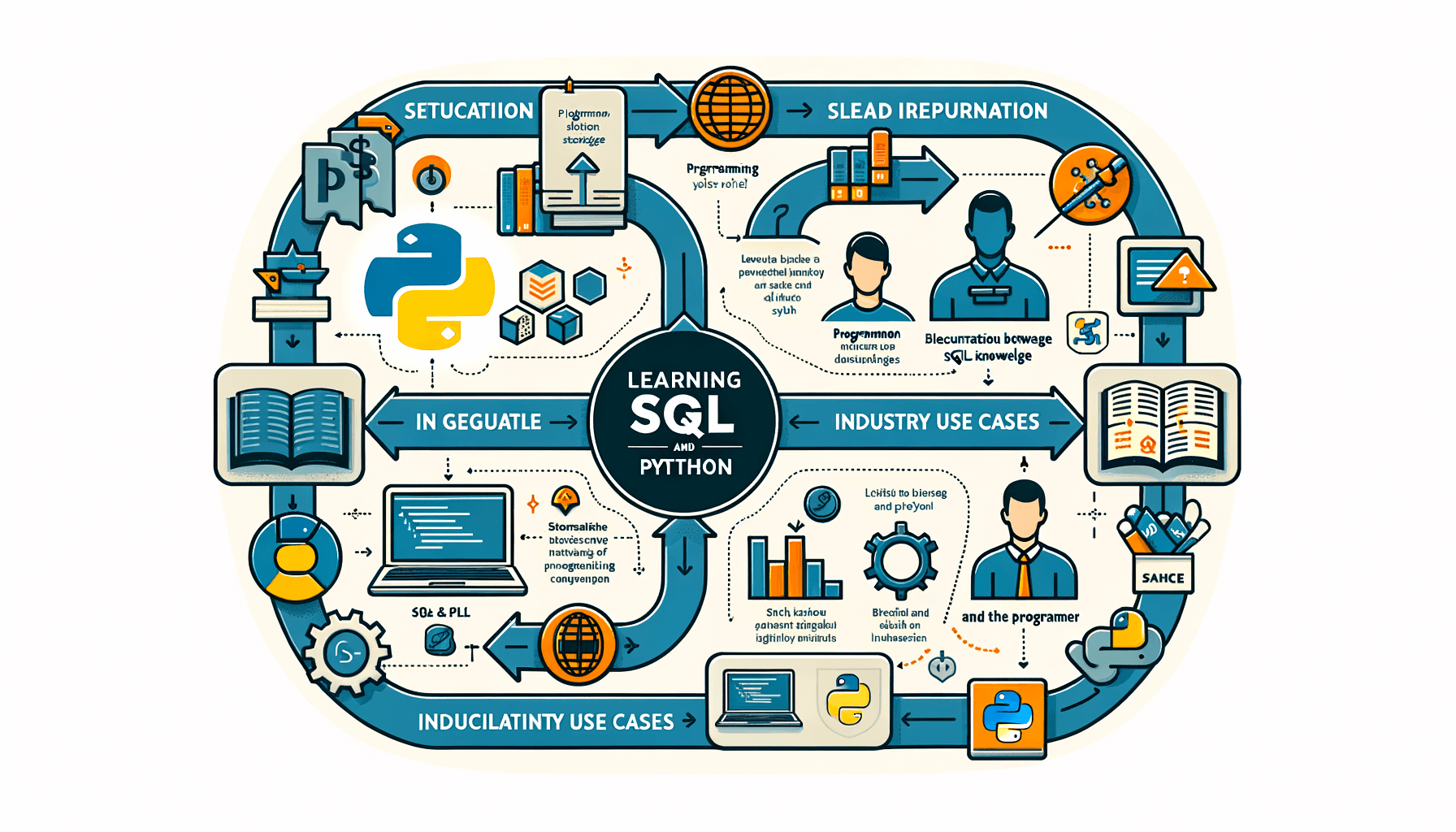A big variety of articles and resources

Mastering Machine Learning with SQL: A Comprehensive Guide
 Sia Author and Instructor
Learn SQL
Sia Author and Instructor
Learn SQL
11 minute read
Machine learning is changing how we solve problems. By mixing machine learning with SQL, we can use the power of databases to make smart choices. This guide will help you learn how to use SQL for machine learning, from basic ideas to real-world uses.
Key Takeaways
- Understanding the basics of machine learning and how it connects with SQL is important.
- Data cleaning and preparation are key steps in any machine learning project.
- Feature engineering can be done using simple SQL queries.
- You can run machine learning algorithms like linear regression and clustering directly with SQL.
- Real-world examples help you see how these ideas work in practice.
Foundations of Machine Learning and SQL Integration
Understanding Machine Learning Concepts
Machine learning is a field of computer science that uses algorithms to learn from data and make predictions. It involves training models on data sets to recognize patterns and make decisions. Understanding these concepts is crucial for anyone looking to integrate machine learning with SQL.
Introduction to SQL and Databases
SQL, or Structured Query Language, is a standard language for managing and manipulating databases. It allows us to perform various operations like querying, updating, and managing data. SQL is essential for handling large datasets, which is a common requirement in machine learning projects.
The Intersection of Machine Learning and SQL
The combination of machine learning and SQL opens up new possibilities for data analysis and prediction. By using SQL queries, we can efficiently prepare and clean data, which is a critical step in any machine learning project. This integration also allows us to leverage the power of databases to store and manage large volumes of data, making it easier to train and deploy machine learning models.
In our mini course: SQL query expansion, we cover advanced SQL techniques for database management, leadership, and challenge-based learning. Gain practical experience with real-world problems through expert-led training for career advancement.
Data Preparation and Cleaning with SQL
Techniques for Data Cleaning
Data cleaning is a crucial step in any machine learning project. It involves identifying and correcting errors or inconsistencies in the data to ensure its quality. Effective data cleaning can significantly improve the performance of your machine learning models. Some common techniques include removing duplicates, correcting data entry errors, and standardizing formats.
SQL Queries for Data Transformation
SQL is a powerful tool for transforming data. We can use SQL queries to filter, sort, and aggregate data, making it easier to analyze. For example, we can use the SELECT statement to choose specific columns, the WHERE clause to filter rows, and the GROUP BY clause to aggregate data. These transformations help in preparing the data for machine learning algorithms.
Handling Missing Data in SQL
Missing data is a common issue in datasets. It can lead to biased results if not handled properly. In SQL, we can use functions like COALESCE to replace missing values with a default value, or IS NULL to filter out rows with missing data. Another approach is to use imputation techniques to estimate the missing values based on other available data.
Proper data preparation and cleaning are essential for building reliable machine learning models. By leveraging SQL, we can efficiently clean and transform our data, setting a strong foundation for our machine learning tasks.
Feature Engineering Using SQL
Creating New Features from Existing Data
In the realm of machine learning, creating new features from existing data is crucial. We can use SQL to derive new insights by combining or transforming columns. For instance, if we have a table with sales and cost, we can create a new feature called profit by subtracting cost from sales. This new feature can provide a deeper understanding of the business performance.
Normalization and Scaling Techniques
Normalization and scaling are essential steps in preparing data for machine learning models. Normalization involves adjusting the values in a dataset to a common scale, often between 0 and 1. This ensures that no single feature dominates the model due to its scale. In SQL, we can achieve normalization using simple arithmetic operations. For example, to normalize a column age, we can use the formula (age - min_age) / (max_age - min_age).
Using SQL for Feature Selection
Feature selection is the process of identifying the most relevant features for a machine learning model. By using SQL queries, we can filter out less important features and focus on those that have a significant impact on the model's performance. This can be done by analyzing the correlation between different features and the target variable. For example, we can use SQL to calculate the correlation coefficient between sales and profit to determine if sales is a good predictor of profit.
Feature engineering is a critical step in the machine learning pipeline. It involves creating, transforming, and selecting features to improve the performance of the model. By leveraging SQL, we can efficiently perform these tasks and gain valuable insights from our data.
Implementing Machine Learning Algorithms with SQL
Linear Regression with SQL
Linear regression is a fundamental technique in machine learning. We can use SQL to perform linear regression by leveraging its powerful querying capabilities. By using SQL, we can efficiently calculate the necessary statistics such as means, variances, and covariances directly from our database. This approach eliminates the need to export data to external tools, streamlining the process.
Classification Techniques Using SQL
Classification is another core machine learning task. With SQL, we can implement various classification algorithms like logistic regression and decision trees. SQL's ability to handle large datasets makes it ideal for training and testing classification models. We can write SQL queries to compute probabilities and make predictions, ensuring that our models are both accurate and scalable.
Clustering Methods in SQL
Clustering helps us group similar data points together. SQL can be used to perform clustering by calculating distances between data points and assigning them to clusters. Techniques like K-means clustering can be implemented using SQL queries, allowing us to analyze and segment our data directly within the database. This method is particularly useful for tasks such as customer segmentation and market analysis.
Using SQL for machine learning tasks not only simplifies the workflow but also leverages the power of databases to handle large volumes of data efficiently.
Model Evaluation and Validation in SQL
Techniques for Model Validation
When we build machine learning models, it's crucial to validate them to ensure they perform well on new data. Model validation helps us understand how our model will generalize to unseen data. One common technique is to split the data into training and testing sets. This way, we can train the model on one part and test it on another.
SQL Queries for Performance Metrics
To evaluate our models, we need to measure their performance. SQL can help us calculate various metrics like accuracy, precision, recall, and F1 score. For example, we can use SQL queries to count the number of true positives, false positives, true negatives, and false negatives. These counts can then be used to compute the performance metrics.
Cross-Validation Using SQL
Cross-validation is another method to assess the performance of a model. Instead of splitting the data just once, we split it multiple times and train the model on different subsets. This gives us a better estimate of how the model will perform on new data. In SQL, we can automate this process by writing queries that handle the data splits and model training.
Validating and evaluating our models is a key step in the machine learning process. It ensures that our models are not just fitting the training data but are also capable of making accurate predictions on new, unseen data.
Advanced Topics in Machine Learning with SQL
Time series analysis is crucial for understanding data points collected or recorded at specific time intervals. In SQL, we can use various functions to handle and analyze time series data. Mastering these techniques allows us to forecast trends and make data-driven decisions. For instance, we can use SQL to calculate moving averages, identify seasonal patterns, and detect anomalies in data.
Natural Language Processing (NLP) involves analyzing and understanding human language. With SQL, we can manage and process text data efficiently. By leveraging SQL's text functions, we can perform tasks such as tokenization, sentiment analysis, and keyword extraction. This integration enhances our ability to derive insights from textual data, making it a powerful tool for data scientists.
Deep learning models require large datasets and significant computational power. Integrating SQL with deep learning frameworks allows us to manage and preprocess data effectively. We can use SQL to filter, aggregate, and join datasets before feeding them into deep learning models. This approach streamlines the data pipeline and ensures that our models receive clean and well-structured data.
By mastering these advanced SQL functions and techniques, we can significantly enhance our data handling and analytical capabilities, giving us a competitive edge in the field of business intelligence.
Case Studies and Practical Applications
Real-World Examples of Machine Learning with SQL
In this section, we explore various real-world examples where machine learning and SQL have been successfully integrated. These case studies highlight the practical applications and benefits of using SQL for machine learning tasks. One notable example is a retail company that used SQL to analyze customer purchase data and predict future buying behavior. By leveraging SQL's data manipulation tools, the company was able to group, filter, and prepare data efficiently, leading to more accurate predictions and better business decisions.
Industry-Specific Applications
Different industries have unique needs and challenges when it comes to data analysis and machine learning. In the healthcare sector, for instance, SQL has been used to predict patient outcomes and optimize treatment plans. Similarly, in finance, SQL helps in detecting fraudulent transactions and managing risks. These industry-specific applications demonstrate the versatility and power of SQL in addressing diverse data science challenges.
Lessons Learned from Implementations
Implementing machine learning with SQL is not without its challenges. One key lesson learned is the importance of data quality and preparation. Poor data quality can lead to inaccurate models and unreliable predictions. Another lesson is the need for continuous learning and adaptation. As new data becomes available, models need to be updated and refined. By understanding these lessons, we can better navigate the complexities of machine learning projects and achieve more successful outcomes.
In summary, the integration of machine learning and SQL offers numerous benefits and opportunities. By mastering SQL's data manipulation tools, we can tackle real-world data science challenges with greater confidence and effectiveness.
In our "Case Studies and Practical Applications" section, we showcase real-world examples of how our courses have helped students succeed. From mastering SQL to advancing in their careers, our students' stories are truly inspiring. Want to see how you can achieve similar results? Visit our website and explore our course offerings today!
Conclusion
In conclusion, mastering machine learning with SQL opens up a world of possibilities for data analysis and predictive modeling. By integrating SQL's powerful querying capabilities with machine learning techniques, one can efficiently handle large datasets and derive meaningful insights. This guide has walked you through the essential concepts and practical steps needed to get started. As you continue to explore and practice, you'll find that the combination of SQL and machine learning can significantly enhance your data-driven decision-making skills. Keep experimenting, stay curious, and you'll be well on your way to becoming proficient in this exciting field.
Frequently Asked Questions
What is machine learning?
Machine learning is a type of technology that allows computers to learn from data and make decisions without being explicitly programmed.
How does SQL help in machine learning?
SQL helps in machine learning by allowing users to manage, clean, and prepare data, which is a crucial step before applying machine learning algorithms.
Can I use SQL for data cleaning?
Yes, SQL is very useful for data cleaning. You can use SQL queries to remove duplicates, handle missing data, and transform data into a suitable format for analysis.
What are some common machine learning algorithms that can be implemented with SQL?
Some common machine learning algorithms that can be implemented with SQL include linear regression, classification techniques, and clustering methods.
Is SQL useful for feature engineering?
Yes, SQL is helpful for feature engineering. You can create new features from existing data, normalize and scale data, and select important features using SQL queries.
Are there real-world examples of machine learning with SQL?
Yes, there are many real-world examples of machine learning with SQL, including applications in finance, healthcare, and marketing, where SQL is used to analyze large datasets and make predictions.
Related Articles

Can a programmer master SQL in a week?
13 minute read

Do I still need to learn SQL if I already know Python?
13 minute read

How did you learn SQL? Did you have a teacher?
14 minute read




